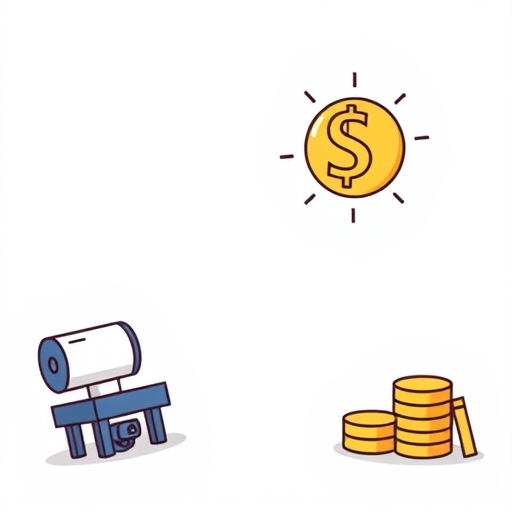Decoding IDR: Understanding Its Multiple Financial Meanings
The world of finance is rich with acronyms, shorthand phrases that condense complex ideas into easily digestible terms. But what happens when a single acronym carries vastly different meanings depending on the context? This is precisely the case with “IDR.” Encountering this abbreviation can lead to confusion if you’re not aware of which financial domain is being discussed.
Think of it like different hats you wear throughout your day. The word “bank” could refer to a financial institution, the side of a river, or even a maneuver in aviation. Similarly, “IDR” can relate to managing student debt, structuring investment partnerships, identifying a national currency, or even investing in foreign stocks. As we navigate the complexities of financial markets and personal finance, understanding these nuances is absolutely crucial.
Our goal here is to serve as your guide, helping you disambiguate the most common financial interpretations of IDR. We’ll break down each meaning, explaining its purpose, function, and relevance in plain, yet professional, language. Ready to shed light on this multifaceted acronym?
Here are three key interpretations of IDR within the financial landscape:
- Income-Driven Repayment plans for student loans
- Incentive Distribution Rights in Master Limited Partnerships (MLPs)
- International currency code for the Indonesian Rupiah
| Term | Meaning | Context |
|---|---|---|
| IDR | Income-Driven Repayment | Student loans |
| IDR | Incentive Distribution Rights | Master Limited Partnerships |
| IDR | Indonesian Rupiah | National currency |
The Most Common “IDR” for Many Americans: Income-Driven Repayment for Federal Student Loans
For millions in the United States, “IDR” is most immediately associated with managing federal student loan debt. Income-Driven Repayment (IDR) plans are a suite of programs offered by the U.S. Department of Education designed to make repaying federal student loans more affordable based on a borrower’s financial situation.

Unlike the standard repayment plan where your payment is fixed and designed to pay off the loan within 10 years regardless of income, IDR plans base your monthly payment on your discretionary income and family size. This means that as your income changes or your family grows, your payment can also change. The core philosophy is to ensure that loan payments don’t become an overwhelming burden, allowing borrowers to meet other essential living expenses.
These plans are particularly valuable for borrowers with high debt relative to their income, or those pursuing lower-paying public service careers who might also qualify for Public Service Loan Forgiveness (PSLF), which often requires enrollment in an IDR plan.
How IDR Student Loan Plans Work: Payments, Forgiveness, and Recertification
The mechanism of IDR plans is relatively straightforward in principle, though the specifics vary between plans. Your loan servicer calculates your monthly payment amount, which is typically a percentage (ranging from 5% to 20%) of your discretionary income. Discretionary income is generally defined as the difference between your adjusted gross income (AGI) and a percentage of the poverty guideline for your family size and state. This percentage varies by plan.
A significant feature of all IDR plans is the potential for loan forgiveness. If your loan balance is not fully repaid by the end of the repayment period – typically 20 or 25 years, depending on the plan and the type of loans you have – the remaining balance may be forgiven. It’s important to note that under current law, this forgiven amount might be considered taxable income by the IRS, though certain legislative changes or temporary waivers have impacted this in the past.
To remain enrolled in an IDR plan and keep your payment calculated based on your income and family size, you must recertify this information annually with your loan servicer. Failing to recertify can lead to your payment reverting to the higher amount based on your original loan balance or interest capitalization, which increases your principal balance.
Navigating the IDR Plan Landscape: SAVE, PAYE, IBR, and ICR
There isn’t just one “IDR plan”; there are several distinct options under the Income-Driven Repayment umbrella, each with slightly different rules regarding payment calculation, eligibility, and forgiveness timelines. Understanding the differences is key to choosing the best plan for your specific situation.
The most current and prominent plan is the Saving on a Valuable Education (SAVE) Plan, which replaced the Revised Pay As You Earn (REPAYE) plan. The SAVE plan offers some of the most generous terms, including potentially lower monthly payments (particularly for undergraduate loans, calculated at 5% of discretionary income) and a provision preventing unpaid interest from capitalizing onto your principal balance as long as you make your calculated monthly payment. This interest benefit is a major advantage over other plans.
Other long-standing IDR plans include Pay As You Earn (PAYE), Income-Based Repayment (IBR), and Income-Contingent Repayment (ICR). PAYE and the original IBR plans (for loans disbursed before July 1, 2014) cap your monthly payment at the amount you would pay under the 10-year Standard Repayment Plan, which can be beneficial if your income rises significantly. The SAVE plan and ICR plans do not have this payment cap.
The IBR plan has two versions: one for new borrowers on or after July 1, 2014 (payments are 10% of discretionary income, 20-year forgiveness), and one for borrowers before that date (payments are 15% of discretionary income, 25-year forgiveness). ICR has a payment calculation that is the lesser of 20% of your discretionary income or what you’d pay on a fixed 12-year payment plan adjusted for income, with 25-year forgiveness.
Who Qualifies for Student Loan IDR? Eligibility Rules and Loan Types
Eligibility for IDR plans depends primarily on the type of federal student loans you hold. Generally, Direct Loans (Subsidized Direct Loans, Unsubsidized Direct Loans, Direct PLUS Loans for graduate students, Direct Consolidation Loans) are eligible for most or all IDR plans.
Older types of federal loans, such as those from the Federal Family Education Loan (FFEL) Program and Federal Perkins Loans, are generally *not* directly eligible for most IDR plans (with some exceptions like certain IBR eligibility for FFEL) unless they are consolidated into a Direct Consolidation Loan. This is a common strategy borrowers use to gain access to a wider range of IDR options, including the SAVE plan and PSLF eligibility.
It is critically important to understand that private student loans are never eligible for federal IDR plans. These loans are issued by banks or private lenders and have their own terms and conditions. Any mention of IDR in the context of student loans specifically refers to federal government loans.
Furthermore, loans that are in default are generally not eligible for IDR plans until they are brought out of default, although initiatives like the Fresh Start program can help borrowers quickly regain eligibility. As of September 2024, defaulted Direct Loans are expected to become newly eligible for the IBR plan as well.
Important Recent Changes to Student Loan IDR Plans (Focus on July 1, 2024)
The landscape of federal student loan repayment is subject to change, and recent updates have significantly impacted the availability of certain IDR plans for new borrowers. As of July 1, 2024, new enrollments in the PAYE and ICR plans are generally no longer accepted.
This change steers most new IDR applicants towards the SAVE plan, which is designed to be the most affordable option for many borrowers due to its lower discretionary income percentage calculation (for undergraduate debt) and interest benefits. There are limited exceptions allowing *existing* PAYE or ICR borrowers to remain on their plans or for Parent PLUS loan borrowers who consolidate to access ICR.
These changes underscore the dynamic nature of federal student aid policies. It’s essential for borrowers to visit the official Federal Student Aid website or contact their loan servicer for the most up-to-date information on eligibility and plan availability. Using the Department of Education’s Loan Simulator tool can help you compare estimated payments under different eligible plans.
IDR in the Energy Sector: Incentive Distribution Rights in MLPs
Shifting gears entirely, we encounter a completely different “IDR” within the financial structure of certain companies, specifically Master Limited Partnerships (MLPs). Here, IDR stands for Incentive Distribution Rights.
MLPs are business structures that combine the tax benefits of a partnership with the liquidity of publicly traded securities. They are commonly found in the energy sector, owning infrastructure assets like pipelines and storage facilities, which generate steady cash flows. MLPs typically have two types of partners: the Limited Partners (LPs), who are the public investors providing capital, and the General Partner (GP), which manages the partnership’s operations.
| MLP Structure | Role of Partners | Cash Flow Distribution |
|---|---|---|
| MLPs combine tax benefits and liquidity | LPs provide capital; GPs manage operations | GPs receive a greater share as cash flow increases |
Incentive Distribution Rights are a contractual arrangement within some MLPs that gives the General Partner an increasing share of the partnership’s distributable cash flow as that cash flow per unit grows past certain predetermined thresholds or “splits.” The idea behind IDRs was to incentivize the GP to increase cash flow and distributions to LPs, as the GP would receive a disproportionately larger slice of the new cash flow growth.
Understanding MLP IDR Structures and Why They’ve Faded
An MLP structure with IDRs typically begins with the GP receiving a very small percentage of cash flow, perhaps 2%. As the quarterly distribution per unit reaches set levels (e.g., $0.50, $0.60, $0.75), the GP’s share of incremental cash flow increases, often stepping up to 15%, 25%, and sometimes even 50% of cash flows above the highest tier. These tiers are the “splits” and the GP’s increasing share is the “incentive.”
While initially seen as a way to align GP and LP interests for growth, IDRs largely fell out of favor in the MLP market starting around 2016. Why the decline? Several factors contributed.
- IDRs increase the MLP’s cost of capital.
- The structure was often perceived as complex, misaligning interests.
- Market preference shifted towards simpler corporate governance.
As a result, many MLPs either eliminated their IDRs by buying them out from the GP or converted from an MLP structure to a traditional corporation. While some legacy IDRs may still exist in certain partnerships, they are far less common in newly formed or restructured entities today.
IDR as a National Currency: The Indonesian Rupiah
Let’s pivot once more to another context where “IDR” is a critical financial identifier: international currency. In this case, IDR is the official ISO 4217 currency code for the Indonesian Rupiah.
The Indonesian Rupiah is the legal tender of the Republic of Indonesia, Southeast Asia’s largest economy and the world’s fourth-most populous nation. Its symbol is “Rp“. Like any national currency, its value and stability are paramount to Indonesia’s domestic economy and its role in international trade and finance.

Bank Indonesia, the nation’s central bank, is responsible for issuing and managing the Rupiah, including setting monetary policy that influences inflation, interest rates, and the currency’s exchange rate against other global currencies like the US dollar (USD), Euro (EUR), or Japanese Yen (JPY). The Rupiah’s exchange rate fluctuates based on a complex interplay of economic factors, including Indonesia’s economic growth, inflation rate, interest rates, political stability, commodity prices (as Indonesia is a major commodity exporter), and global capital flows.
Trading and Understanding the Indonesian Rupiah
For investors, businesses engaged in international trade with Indonesia, or travelers visiting the country, understanding the Indonesian Rupiah (IDR) is essential. Its value directly impacts the cost of goods and services, the profitability of exports and imports, and the return on investments denominated in Rupiah.
The Indonesian Rupiah is actively traded on foreign exchange markets. While perhaps not as widely traded as major pairs like EUR/USD or USD/JPY, it is a significant currency in emerging markets, particularly within Asia. Trading the Rupiah involves analyzing Indonesia’s economic health, monetary policy signals from Bank Indonesia, and broader sentiment towards emerging market currencies.
If you’re exploring opportunities in foreign exchange trading or considering how global economic factors influence currency values like the Indonesian Rupiah, understanding how to access these markets is key.
如果你正考慮開始進行外匯交易或探索更多差價合約商品,那麼 Moneta Markets 是一個值得參考的平台。它來自澳洲,提供超過 1000 種金融商品,無論是新手還是專業交易者都能找到合適的選擇。
Such platforms provide the means to trade various currency pairs, including potentially those involving the IDR, and instruments like CFDs (Contracts for Difference) that allow speculation on price movements without owning the underlying asset.
IDR as a Global Investment Tool: Depository Receipts
Our final meaning for “IDR” takes us into the realm of international equity markets. Here, IDR can stand for International Depository Receipt, or more specifically, Indian Depository Receipt in the context of investing in India. This “IDR” is a financial instrument designed to simplify cross-border investment.
Investing directly in shares of a foreign company can be cumbersome. It often involves dealing with foreign brokers, different regulations, currency conversion complexities, and potentially inconvenient settlement processes. Depository Receipts were created to bridge this gap.
An International Depository Receipt is essentially a negotiable certificate issued by a depositary bank. This bank purchases shares of a foreign company’s stock and holds them in trust. The bank then issues Depository Receipts in the local market, with each receipt representing a certain number of shares (sometimes one-for-one, sometimes a ratio). These receipts trade on local stock exchanges just like shares of domestic companies.
| Type of Receipt | Definition | Market Focus |
|---|---|---|
| ADR | American Depository Receipt | U.S. stock exchanges |
| GDR | Global Depository Receipt | International markets |
| IDR | Indian Depository Receipt | Indian stock exchanges |
How Depository Receipts Facilitate Access to Foreign Equities
For investors, Depository Receipts offer convenience, liquidity, and the ability to trade foreign stocks during local market hours using their regular broker. They are denominated in the local currency (e.g., USD for ADRs, INR for IDRs in India). The price of a Depository Receipt is closely linked to the price of the underlying foreign shares, adjusted for the exchange rate and the ratio of shares per receipt. Any significant price difference between the receipt and the underlying shares creates an arbitrage opportunity, which helps keep the prices aligned.
For foreign companies, issuing Depository Receipts can broaden their investor base, enhance their visibility, and potentially make it easier and cheaper to raise capital compared to a full foreign stock exchange listing. It provides a streamlined pathway to access international investors.
Investing in global markets, whether through Depository Receipts or other instruments like CFDs on international indices or stocks, requires access to platforms that facilitate diverse trading opportunities. When considering platforms that allow you to explore these global markets and asset classes, including major currencies or instruments tracking foreign equities, factors like available instruments, trading tools, and regulatory compliance become important.
若你正在尋找具備監管保障且能全球交易的外匯經紀商,Moneta Markets 擁有 FSCA、ASIC、FSA 等多國監管認證,並提供資金信託保管、免費 VPS、24/7 中文客服等完整配套,是不少交易者的首選。
Context is King: Distinguishing the IDRs in Finance
As we’ve seen, the simple three-letter acronym “IDR” is a prime example of how context is paramount in financial terminology. Without knowing the specific area of finance being discussed – be it federal student loans, energy partnerships, international currency markets, or cross-border investing – the meaning of IDR remains ambiguous.
Whether you are a student loan borrower navigating repayment options, an investor considering exposure to MLPs or international stocks, or someone involved in international trade or currency markets, correctly identifying which “IDR” is in play is the essential first step to understanding the relevant information and making informed decisions.
The complexity of finance means that clear definitions and attention to detail are non-negotiable. By breaking down acronyms like IDR and understanding their multiple lives within the financial ecosystem, you build a stronger foundation for your financial literacy and decision-making journey. Always clarify the meaning of any acronym based on the specific financial context you are encountering.
Armed with this knowledge, you can confidently distinguish between managing student debt with Income-Driven Repayment, analyzing the structure of a Master Limited Partnership with Incentive Distribution Rights, recognizing the Indonesian Rupiah in currency markets, or utilizing International Depository Receipts to invest globally. Each represents a distinct concept, vital to understand within its own domain.
what does idr mean in moneyFAQ
Q:What does IDR stand for in student loans?
A:IDR stands for Income-Driven Repayment, a program to make federal student loans more affordable based on income and family size.
Q:How do Incentive Distribution Rights work in MLPs?
A:Incentive Distribution Rights (IDRs) allow the General Partner of an MLP to receive a larger share of cash flow as it increases, incentivizing growth.
Q:What is the value of the Indonesian Rupiah?
A:The Indonesian Rupiah (IDR) is the national currency of Indonesia, and its value is determined by various economic factors, including inflation and trade balances.
